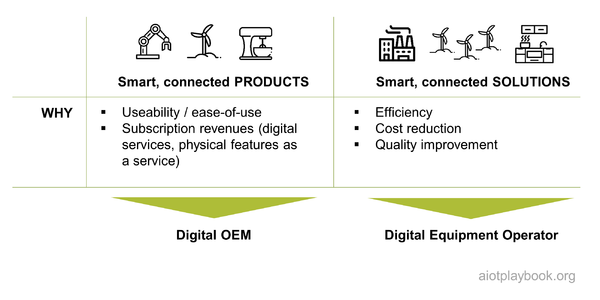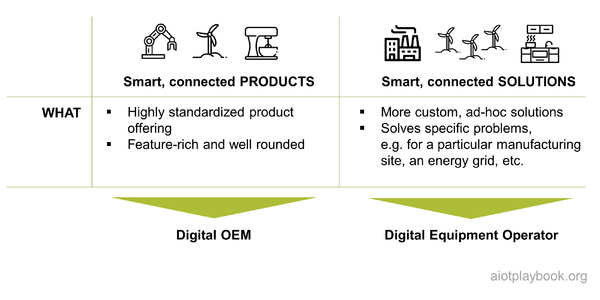
The key element of the AIoT Framework are the why, what, who and how perspectives, inspired by the work of Simon Sinek [1] as well as the St. Gallen IoT Lab [2]:
- Why: Better understand and articulate the purpose and AIoT-enabled business outcomes
- What: What can be achieved with AIoT in terms of smart, connected products and solutions
- Who: Roles and responsibilities in the context of an AIoT initiative
- How: Project blueprint for AIoT execution and delivery
Why: Purpose and AIoT-enabled business outcomes
While AI and IoT are exciting technical enablers, anybody embarking on the AIoT journey should always start by looking at the "why": What is the purpose? And what are the expected business outcomes?
From a strategic (and emotional) point of view, the purpose of the AIoT initiative should be clearly articulated: What is the belief? The mission? Why is this really done?
For the business sponsors, the expected business outcomes must be clearly defined as well. As will be discussed in the "what" section, most AIoT initiatives are either focusing on products or solutions. Depending on the nature of your initiative, the KPIs will differ. For AIoT-enabled products, they tend to focus more on the customer acceptance and revenue side, while for AIoT-enabled solutions they tend to focus more on efficiency and optimization.
More details on the "Why" of an AIoT initiative can be found here.
What: Smart, connected products and solutions
The "What" of an AIoT inititive can usually be described as a smart, connected product or solution. This is an important differentiation, which is discussed here.
Smart, connected products are often very highly standardized, feature-rich and well rounded. Smart, connected solutions on the other hand are often more custom, ad-hoc solutions. They are often designed to solve a specific problems, e.g. for a particular production site, a particular energy grid, etc.
Obviously, this is not a black and white differentiation. There are also often cases which are a bit of both, product and solution. A good example is a standardized retrofit solution for elevator monitoring, which is offered as a product.
Who: AIoT roles and responsibilities
The "Who" perspective must address the roles and responsibilities required for successfully delivering your AIoT initiative. These will partially be different for product- vs. solution-centric initiatives, as we will discuss later.
The AIoT Framework is primarily addressing product/solution managers, project/program managers, development/engineering managers, product/solution architects, security/safety managers, and procurement managers.
How: Getting things (and AI) done
The now widely accepted agile project methods in the IT world are heavily based on incremental value creation and continuous improvement. Business models are evaluated early using MVPs (Minimal Viable Products), and the fine-tuning of the business model is rapidly supported by agile sprints. This works well in IT, especially supported by cloud-based development. For AIoT, the constraints of the physical world have to be taken into consideration, including longer lead times and safety requirements. This can require longer-term planning and increased focus on verification and validation - especially for smart, connected products. For smart, connected solutions, this can look differently. From a "how" perspective, it is important to understand this differentiation and its implications.
Furthermore, the "how" perspective needs to address how to best utilize AI and IoT together. And finally, how to execute and deliver the AIoT-enabled product or solution. Both aspects are addressed in the following.
Utilizing AI and IoT together
The smartness of an AIoT product/solution is usually either related to an individual physical asset ("asset intelligence"), or to a group/fleet of assets ("swarm intelligence"). Technically, asset intelligence is enabled via edge computing, while swarm intelligence is enabled via cloud computing. Asset intelligence is applying AI-algorithms to data which is locally captured and processes (via sensors), while swarm intelligence is applying AI-algorithms to data which is captured from multiple assets via IoT-technologies in the cloud.
From a "How" point-of-view, it is important to clearly identify what kind of features AI and IoT are actually enabling - and whether they are actually really required (click here for a more detailed discussion).
AIoT execution and delivery
The combination of AI and IoT is not only a powerful one, but also one which is potentially adding a significant level of complexity - especially when compared to a traditional IT project. The AIoT Framework aims to provide a holistic view on how to successfully execute an AIoT initiative by addressing these complexities step by step.
From a business point of view, the "how" must address the value proposition and key differentiators - aspects which should actually be clarified before the "what" is addressed.
The AIoT Framework is describing a detailed approach for execution and delivery of AIoT-enabled products and solutions, which not only includes the business perspective, but also the hard- and software perspective, as well as the perspective of the physical asset and how it is manufactured. Applying this method usually only makes sense if the answer to the "what" question is AIoT. This is why in this section the "how" comes after the "what". However, the framework also assumes an agile and explorative approach as far as possible (subject to limitations imposed by the safety- and planning-centric hardware and asset-related processes), which is why there will usually be no waterfall-like sequence in the processing of the why/how/what-questions.
AIoT Execution and Delivery is extending existing good practices from the IT/software world, adding specifics of AIoT-enabled product/solution development. Execution and Delivery includes business model, product/solution architecture, DevOps & infrastructure, trust & security, reliability & resilience, and verification & validation. In addition, the product/solution organization is addressed, as well as technology & resource acquisition, and service operations.
About the AIoT Framework
The AIoT Framework provides good practices for AIoT product and project managers, helping to improve quality and customer centricity, reduce risks and costs, and shorten time-to-market.
The AIoT Framework is a continuation of the original Ignite IoT framework, based on the Enterprise IoT book (Slama, Puhlmann, Morrish, Bhatnagar; O`Reilly 2015). The AIoT framework is also building on additional research in the area of best practices for smart, connected products.
The framework is managed by the AIoT User Group, which has driven the evolution of Ignite from a generic IoT framework towards an integrated AI and IoT framework. The group is focusing on experience sharing and best practices for AIoT, including Ignite Talks AIoT Case Studies, AIoT Boot Camps and development of the AIoT Framework.

Please contact the AIoT User Group via this form if you want to get involved!







